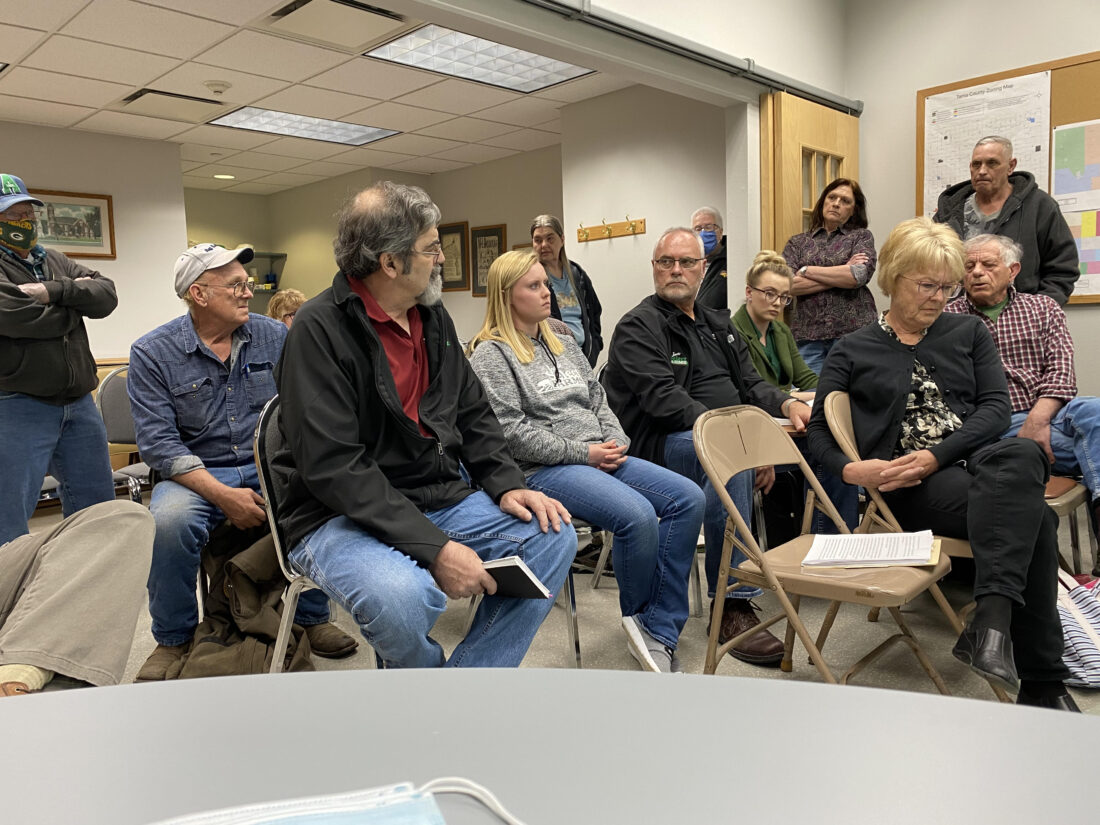Proposed Tama County hog confinement proves controversial

Ken Pliner of Iowa Select, left, along with three other company representatives, meets with neighbors of a proposed hog confinement project in Tama County at a board of supervisors meeting on April 25.
TIMES-REPUBLICAN
TOLEDO — Iowa Select Farms sent Ken Pliner and three other representatives to meet with the Tama County Board of Supervisors on April 25 to answer questions and concerns from the community.
The main frustration from residents who attended the meeting was a lack of communication from Iowa Select to people whose properties will be neighboring the four proposed sites.
Among the questions that were brought to Pliner was if their construction will also be affected the same way the Otter Creek Lake restoration has been halted due to the Indiana bat, which is an endangered species. Pliner was unaware if that would have any effect on the project.
While the endangered species is a concern, there will be no federal funding for the confinements, which means that they would not need approval from the EPA.
Eric Lyon, a Tama resident, expressed his argument as to why construction should be delayed.
“Because not even one neighbor was contacted by either land owners, Iowa Select, Crystal Finishers, for citing large commercial hog factories — because Iowa Select made no good faith effort to be good neighbors that they advertise being, — because the DNR’s (Department of Natural Resources) own employees a few years ago when the permit was denied in another area that it would be nearly impossible for the DNR with their manpower to check every manure management plans phosphorus index — for every hog confinement field that was applied for,” Lyon said. “Really what we’re asking for is some time to check it out before the permit gets approved.”
Another Tama resident at the meeting asked Pliner what being a good neighbor meant to him. “Odor control, placement that meets all the rules and regulations or exceeds them,” he responded.
The master matrix was also called into question. Tama County Supervisor Dan Anderson said the board had reviewed and approved it, but asked the questioner if he had found something they could have missed.
“We think in reading that there’s a very easy way to overlook, particularly in phosphorus numbers and manure spreading,” the attendee said.
Transmission of odor is another problem that can cause issues for people who neighbor the farm. Pliner said they plan on taking an extra precaution to combat this issue.
“We put electrostatic fences on the end of these blinds, (and) another thing we do is we put two rows of trees throughout three sides of these barns. We have talked about and would be willing to propose that on this site we would put a third row of fast growing oss trees,” Pliner said. “They’ll grow up fast and give us more wind blockage and odor blockage, while the more mature trees have more time to get established… Our plan will be after 10 to 15 years, we’ll go and rip them back out and our mature trees should be big enough to help control (wind and odor blockage).”
Residents continued to question the location of the barns.
“In 3500 acres, there were no other sites that you thought were as good as this one, or adequate to put a building on further away from our area,” one said.
“It sounds ridiculous that you can’t find a better site in 3500 acres. You said move it up by the water tower. That just makes a different group of people unhappy,” Pliner responded.
When questioned on the site’s location despite poor road access, Pliner said the company felt it was the best spot they could map because the elevation changes are “too dramatic” on 260th Street, making it harder to build and harder to control.
Delays and setbacks are common according to Pliner, who commented, “You have to physically look at every location and everything around it that could possibly affect it.”
Neighboring property owners made note that they are not against the site but remain bothered by the lack of communication from Iowa Select about the location.
“I’m not against hog buildings necessarily. I just think sighting is really important and this is terrible,” Lyon said.
Another resident who attended the meeting said “You didn’t ask the neighbors, and that’s what ticks us off.”
Pliner responded, “I understand what your concern is. I don’t want this to sound bad, but if we asked the neighbors before we ever placed a site, do you know how many buildings we would build?”
“I have no idea,” the attendee said.
“None!”
“I’m not trying to make an excuse, but it’s not part of the process that we go out and ask permission to put a building there. Our process is that we follow all DNR rules and regulations and guidelines.”
Pliner continued “I know everybody didn’t like the way we did it or the way we do it, but we apply for the permit. It gets put on your guys’ agenda (the board of supervisors). We do a DNR site visit, then we go around to answer any questions any close neighbors might have or explain what we’re doing.”
Supervisor Dan Anderson asked Pliner if there was a possibility to move the site, and he said while there was a chance, the current site meets all rules, regulations and requirements.
While the building of the facility is inevitable, Iowa Select will continue to look at other sites, and a letter will be sent to the DNR recapping the opposition from a group of local residents who showed concerns with the farm’s location. This does not guarantee any changes, however, as the site has already passed the Master Matrix site evaluation criteria.





